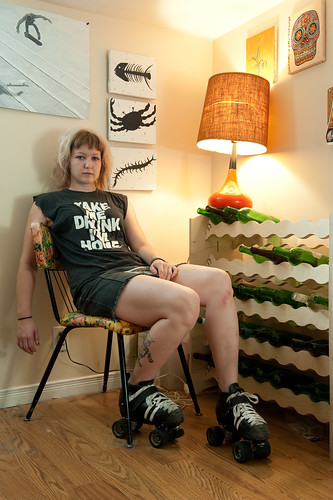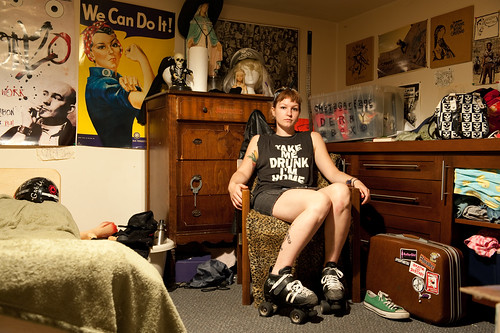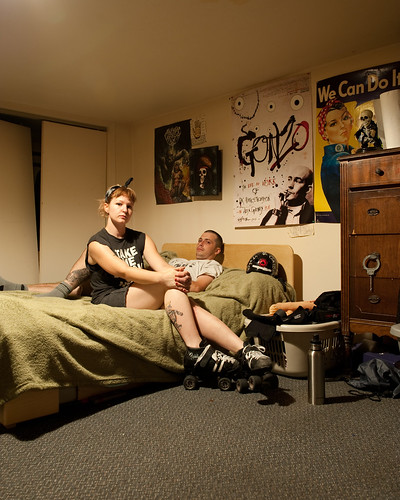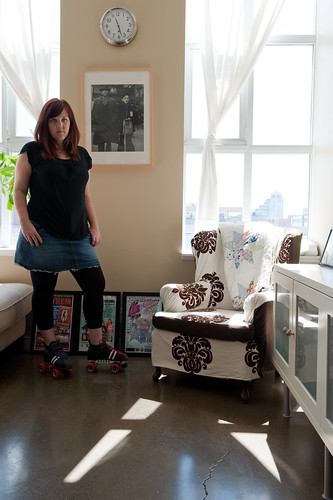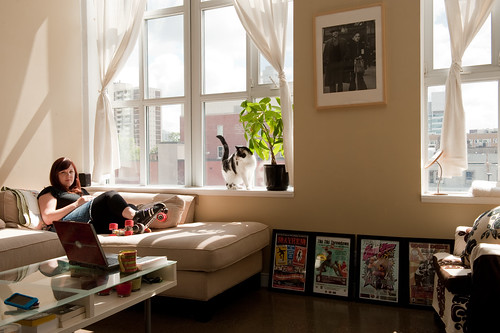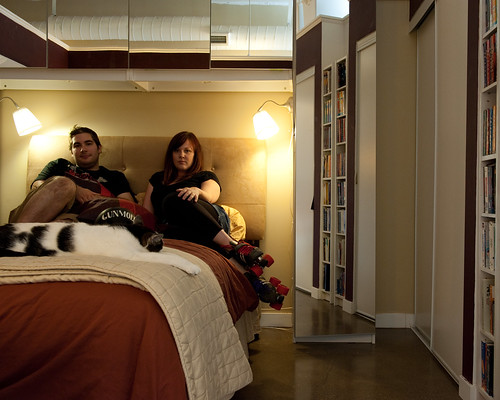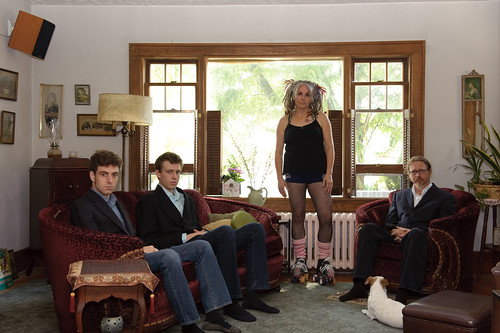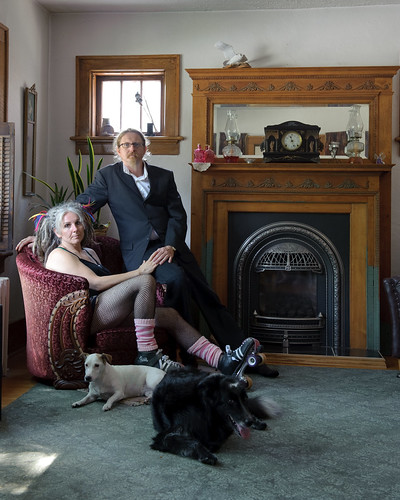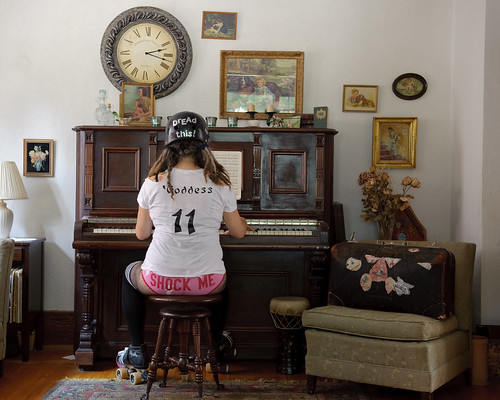I’ve been thinking about the subject I’m about to write about for a long time. But there’s a real risk in writing about it… Ever since a wee run-in with a certain very well-known photography blogger shortly after I started this blog, I’ve shied away from saying anything potentially contentious here. Sometimes I feel handicapped because I don’t have any formal education in art, so the words don’t come easily to talk about photography. Or I worry I’ll say something that’s just plain wrong, and I don’t know it yet. But I’ve been thinking about this for a long time and I think the time has come.
So I might as well just get into it.
Have you noticed that feminism seems to have become the new F word? When you utter it in polite circles, people – both men and women – often respond as though they’ve been slapped. Well, maybe more like you just started talking about the time you had a pilonidal cyst. Some horror, some revulsion and a generous helping of fear for what’s about to come out of your mouth. When I was in university in the 90s, feminism, in those circles at least, was almost always referred to in the plural, because there were as many feminisms as feminists. But a decade later, it seems like in more mainstream circles there is only one kind of feminist, and she hates men and she’s frothing at the mouth she’s so enraged. That is not the kind of feminism I subscribe to.
I don’t blame individual men for the changes that still need to be made to achieve gender equality. Men are subject to the same cultural messages we women are. To me, feminism is about equality for all and about challenging our beliefs about gender; not about disempowering men to empower women. And membership is open to men as well as women. My husband considers himself a feminist. I consider him a feminist too, in case you’re wondering.
It seems like the singular, currently popular definition of a feminist only serves to hinder discussion on issues that we really need to talk about.
For example.
500 Photographers, which I’ve been really enjoying following, as far as I can tell, has only covered 17 women out of the 94 photographers it’s so far covered. That’s 18 percent. Now, I’m not blaming the author of the blog. I think it’s a great undertaking, and as I’ve said, I’m really enjoying it, for one. The fact is photography is dominated by men. Although women have been using cameras ever since their invention, they just don’t seem to stick around in the canon in the same numbers as men. Just look at Magnum’s group photo from its annual general meeting in June. There are 3 women. Out of 38 full members, that’s 8 percent. Not even 10 percent. And that’s rounding up!
I really think the problem is that the standards by which photography is judged are male standards. There are women who can meet the standards, obviously, but what about the women who can’t or don’t want to?
I couldn’t help but notice that work from my Two-Powered series was very well-received in art circles outside of photography. My work was included in Mother/mother-*, an exhibition about motherhood (duh) that included works in ALL media. My work was seen there, and is being included in an academic book now about mothers in contemporary art. I say this not to toot my own horn, but to notice that my work has seen zero interest in photography circles. Maybe it’s just because the pictures suck, and I’m ok with that possibility. But there are photographers, and women photographers too, whose work is renowned in photography circles that also suck in formal terms. That are more about what’s in the photo than how beautiful it is.
* * *
There’s a group on flickr I’ve been a member of for a couple of years now, called La Familia Abrazada. It’s an interesting pool of work, inspired by such photographers as Nan Golden and Tina Barney among others, and it was even featured on Burn magazine last fall I think. Last summer, someone posed the question, why are there only women and children in the group’s pictures? Where are the men? Well, there certainly are more male contributors to the pool. It’s a moderated pool, so contributors first add their image(s) to be considered, and the moderator(s) decide whether to admit it into the pool. At the time of the discussion, there were no women moderators of the pool. I don’t know if that’s since changed.
But the discussion stayed pretty rooted in the question of subject matter, and how to get the male photographers out in front of the lens. Because the important thing, I guess, is to SEE men. I did try to broach what *I* think should have been the focus: who’s behind the camera of the images. I mean, if your pool is lacking women photographers, there’s a reason, and it’s not simply that only men are drawn to photograph their families. I’ll stick my neck out and say that in fact, I would guess MORE women are drawn to photograph their families than men, since it’s still a fact that women are more often primary caregivers than men. So the pool should at least have even representation.
Anyways, after the discussion, I gamely submitted a few images of my husband. But the pictures were rejected by the moderators. When I privately messaged one of them to ask why, he said they did not strike him, that they weren’t bad, they just didn’t have enough ooomph for him. The thing is, he’s right. They do lack oomph. But that was kinda the point of them. Domestic life is kinda like that, mostly lacking oomph. Don’t get me wrong, I love my family life, but it’s not really given to grand moments. I like my family/domestic pictures if they have ambiguity, if they’re open-ended. I like it when they’re a bit surreal, when you can’t quite figure out what’s going on, or when they suggest something that had absolutely no bearing in the original situation.
Just in case you’re wondering, these are the pictures I submitted then.
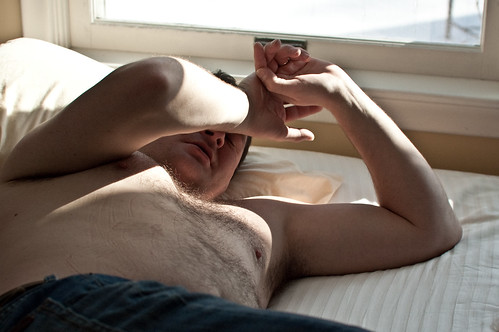
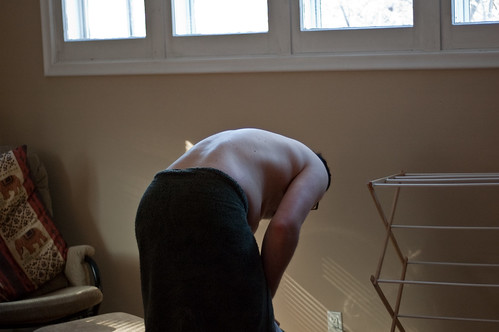
Maybe they are lousy pictures, I don’t know. But I do know that throughout my participation in the group, I’ve experimented with submitting photos to see which ones get in. And honestly? I have to say the ones that get in are the ones that I generally find to be a bit cheesy, overly sentimental, or plainly humourous. Which is odd since the pool itself is not cheesy or overly sentimental.
Now this isn’t a complaint about my pictures not getting in, and certainly not a complaint against the moderators, it just seems like this is yet another example of male domination in photography, and kind of a huge blind spot when discussions come up. I don’t think the discussion should be about subject matter all. Well, it’s part of the issue, but it’s more of a symptom, I think. And I hate essentialist ideas of gender, so I need to be careful here. And of course, I really don’t want to come off as a Rabid Manhating Bitter Old Feminist. Or sour grapes.
Gah. This is the part where I can’t find the words.
…
Ok, so I’m stuck. I decided to check out the ratio of men to women in some of my books. Image Makers Image Takers has interviews with 20 photographers. Five of them are women. (Incidentally, it was edited by a woman.) That’s 25 percent.
The photograph as contemporary art, by Charlotte Cotton, which I highly recommend btw, discusses 219 photographers, give or take a few. Ninety-one of them are women, which is 42 percent. I went from the index, and I may have double counted one or two, so take the absolute numbers with a grain of salt. But still, that’s a vast difference from 8 or 18 percent.
I currently have Reframings: New American Feminist Photographies from the library. It has a foreword by Anne Tucker, in which she sites a source that says that by 1910, women made up 20 percent of the photographic work force in America. She goes on to say: “Women actively participated in every significant photographic movement and school of the twentieth century. [...] As a young historian I discovered that a little digging in any period yielded important women who had been exhibited and published locally, nationally, and internationally. Women’s representation and the acknowledgment of their contributions declined or disappeared only when later historians evaluated a movement. The more general the compendium, the less likely women were to be well represented.” Tucker goes onto to recount her experience in 1973 of writing The Woman’s Eye, which featured 10 women photographers. She notes, “Those knowledgeable about photography tended to dismiss it; general book reviewers and women’s publications praised it highly.” (I actually saw it at the library before I picked out Reframings, but I thought from the title it would annoy me, since woman and eye were singular. I didn’t notice the author’s name or I probably would have gotten it. Next time.)
Anyways, Reframings. I’m disappointed to tell you that I have only heard of four of the 45 women photographers in the book. I was planning to write that I’d heard of none of the photographers in the book, but I figured I’d better make sure that was true and finish looking through the images. That was when I discovered Carrie Mae Weems, Cindy Sherman, Nan Goldin and Catherine Opie in the final chapters. I’d like to believe it’s just a coincidence that three of those four photographers were in the chapter entitled, “Sex and Anxiety,” but I’m not buying it. The fourth, Opie, is a lesbian, and much of her work is concerned with queer identity.
And the photographers I hadn’t heard of? A lot of the work is really good. I’ve seen other books of feminist art, and to be honest a good chunk of it left me flat. But that wasn’t the case with Reframings. So why I haven’t I heard of them?
I don’t know exactly where I’m going with this. It’s complicated, I know. Tucker said it too, when she noticed that Beaumont Newhall only mentioned 13 women photographers in The History of Photography – out of about 500 photographers in total! (I got tired of counting all the photographers by the L’s in the index, so I just estimated.) A footnote explains, “Evaluating Newhall’s support of women is complicated. In over 400 articles written on art between 1925 and 1971, he wrote about only six women: Berenice Abbott, Margaret Bourke-White, Julia Margaret Cameron, Imogen Cunningham, Nell Dorr, and Barbara Morgan. Whatever his basis for excluding women from his publications, Newhall proudly supported his wife’s career and never discriminated among his students. He generously responded to men and women equally with shared research, advice, and recommendations.”
* * *
I started this post with 500 photographers, so I may as well end with it. Here are some ideas for women photographers he might want to consider sharing, in no particular order:
Rineke Dijkstra – This series brought me to tears when I saw it in a book the other day. She photographed three women with their newborns, one was one hour after birth, another one day after birth, and another one week after birth. It was the one with the c-section incision that especially got to me.
Kate Hutchison – I’m particularly fond of her model husband series and also why am I marrying him, but all her work is great
Jodi Bieber
Katharina Bosse – especially Portrait of the artist as a young mother
KayLynn Deveney
Laura Pannack
Jen Davis
Araminta deClermont
Juliana Beasley – especially Rockaways
And that’s just off the top of my head. And being fair, I’d also have to recommend Don Weber. Because I haven’t counted, but there probably aren’t enough Canadians either. But that’s another post.
*Updated: Ugh. This damn post took me all morning, and now I see 500 photographers is up to 95. And it’s Canadian Joey L.
